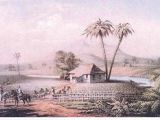Ways of arrival of the havanera to the Peninsula
In Spain, the fashionable songs from the Cuban colony, arrived mainly through the port of Cadiz which, until the end of the 18thC, held the monopoly of the American trade, although they also arrived through other eastern areas of the Peninsula (Torrevieja, Crevillente...), the Cantabrian coast (La Coruña, Bilbao, Luanco, San Vicente de la Barquera...) and salso through the Castilian Channel towards the inner lands of Castilla where nowadays it is celebrated the well-known Havaneres Festival in Mayorga de Campos.
According to the ethnograph Joaquín Díaz, the havanera spread around the Peninsula by three different ways: the folding cane and streamer format, the popular way and the learned way of the zarzuela. Street singers were the ones who used the first spreading way, the folding canes, in which fantastic events were narrated and old ballads and fashionable songs were collected. The songs were sung by blind people whol sold them in markets and public squares, hanged by a rope, thanks to the royal privilege they owned/had. The second spreading way was the one carried out by the musicians, both in rural and ballroom balls. The last of the spreading way was the zarzuela, a kind of musical theatre which enjoyed of great popularity and spreading before the appearance of the new ways amusement, such as the radio and sports, at the end of the 19thC. The zarzuela included scenes in which the protagonists sang havaneres, among other fashionable compositions of the time, such as waltzes, mazurcas, boleros and chotis.

